The Love Triangle Spread
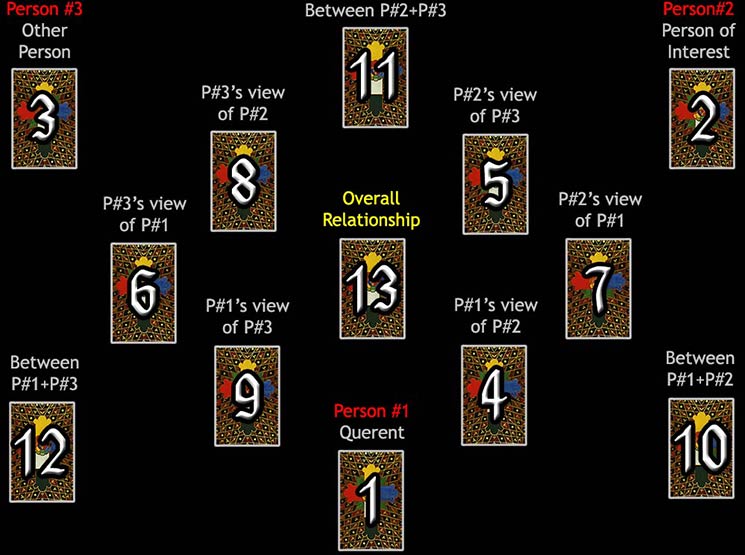
Difficulty: Complicated
Casually referred to as the Love Triangle, this spread can be used to determine the dynamics of the relationship between three people, regardless of whether romance is involved. This spread is arranged in the form of a hexagram, consisting of several large and small triangles. This tarot spread may seem somewhat complicated, but it is not entirely that difficult.
The first step is to interpret the card for each individual position in the spread. Generally, one might ask about a relationship they are involved in, but this does not have to be the case. Ordinarily, the reader's representative card is #1, their main person of interest is #2, and the other person would be #3.
The second step fills in the downward triangle and involves further examination of the individuals through their views of the other people. Each person has two more cards showing the way they see and relate to the other members of the triangle. For example, Card #6 indicates how Person #3 relates to Person #1, while Card #9 stands for Person #1's attitude toward Person #3.
The next step completes the upward triangle and the hexagram, focusing on cards #10–13. It also completes the many smaller triangles and hints at the potential for each relationship. The final card, #13 can be considered the significator of the reading, which suggests the overall potential for this three-way relationship.
Your Love Triangle Reading
| P#3 | 3to2 | 2+3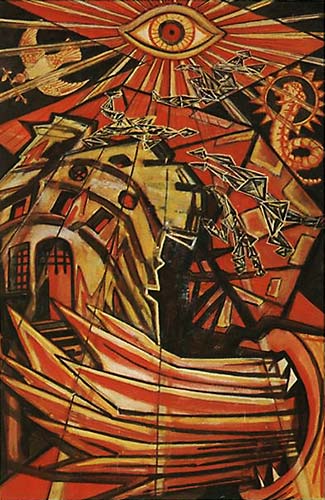 |
2to3 | P#2 | ||
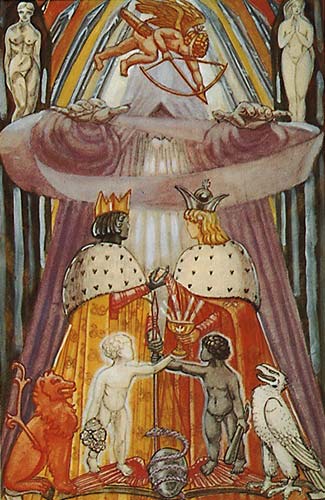 |
3to1 | 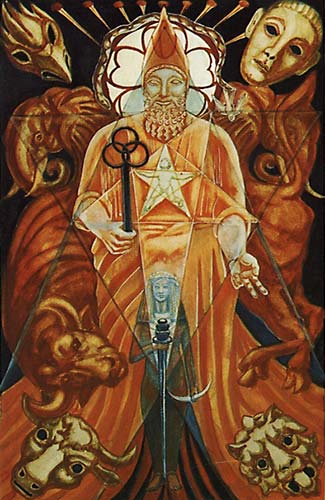 |
Overall | 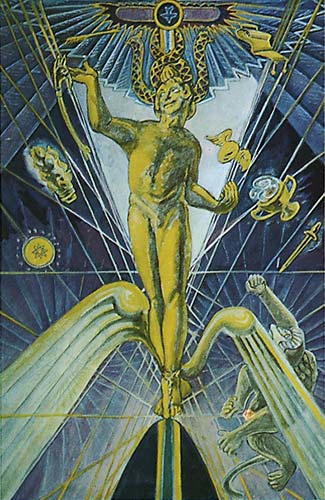 |
2to1 | 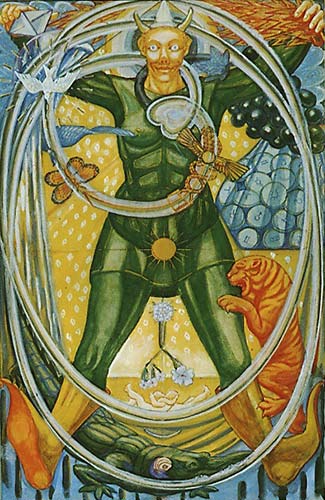 |
| 1+3 | 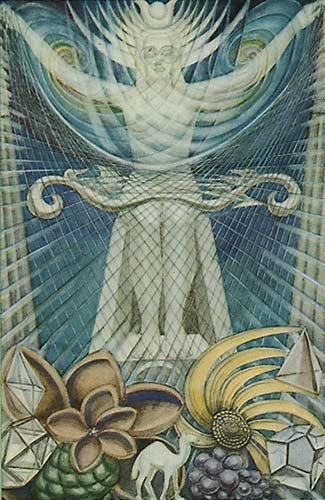 |
1to3 | 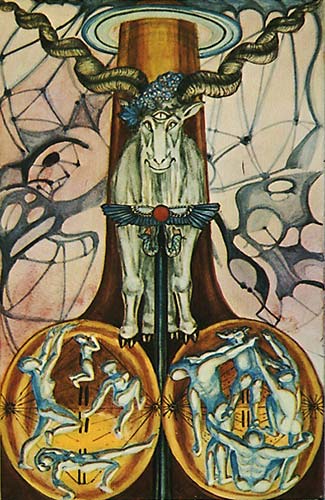 |
1to2 | 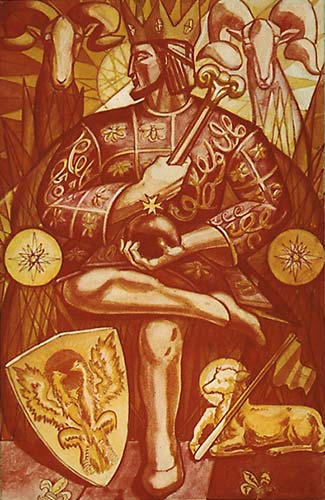 |
1+2 |
 |
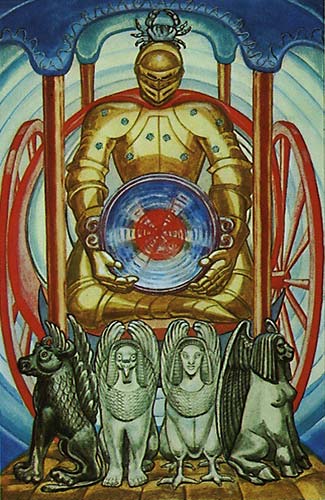 |
P#1 | 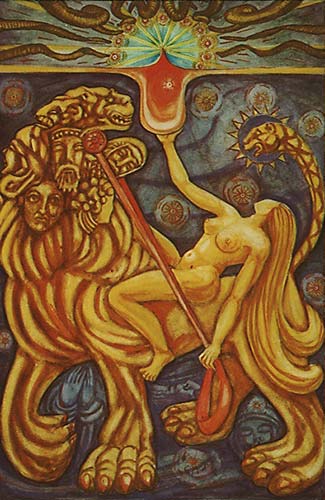 |
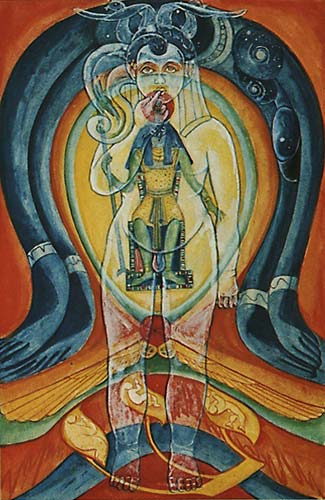 |
||
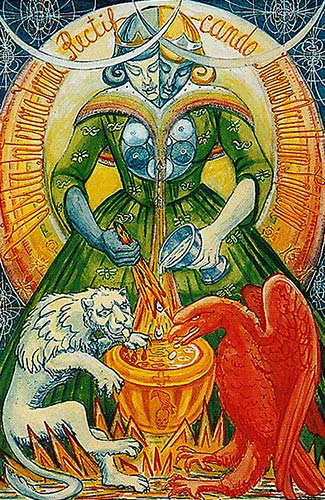 |
1: Person #1

(Sagittarius, Samekh)
Art, traditionally called Temperance, represents the alchemical process of transmutation and the blending of opposites. Associated with Samekh, the prop, this card signifies the support and structure needed to integrate seemingly opposing forces. Sagittarius, the zodiac of exploration and synthesis, infuses the card with visionary energy and optimism.
The central figure is a radiant androgynous being with two faces engaged in an alchemical act of union. They pour liquid from one vessel into another, blending fire and water, symbolising the merging of opposites to create something entirely new. Around them, symbols of the zodiac and alchemical glyphs emphasise the universal nature of this process. The golden background radiates the light of inspiration and higher purpose, while the stream of power arching above the pot signifies hope and divine harmony.
In Relationships: Art represents the balance and integration of differences. It encourages you to find harmony through patience, communication, and mutual understanding.
In Work: This card signifies success achieved through creativity, innovation, and the ability to blend diverse elements into a unified whole. You are advised to embrace flexibility and trust in your creative process.
Spiritually: Art symbolises the quest for inner balance and the alchemical transformation of the self. It calls you to embrace your contradictions and to unite yourself in service of a higher purpose.
When ill-dignified: Art warns of imbalance, lack of focus, or the inability to harmonise opposing forces. You are advised to recalibrate and approach your challenges with patience and creativity.
2: Person #2

(Air, Uranus, Aleph)
The Fool of the Thoth deck embodies the chaotic, boundless energy of pure potential, untouched by form or limitation. He is the alpha and omega of the journey, the primordial force from which all creation arises. Corresponding to Aleph, the breath of life, and the element of Air, the Fool represents the vibrant, unpredictable nature of Uranus, the planet of sudden change and divine inspiration.
The figure of The Fool is richly adorned, standing amid a swirling maelstrom of symbolic forms. He wears motley robes to represent his openness to all experiences, while the winged sun at his feet symbolises the life-giving power of the divine. Around him whirl a tiger (representing instinct and primal fear), a crocodile (a guardian of the mysteries and a symbol of time), and a rainbow-hued disk, representing the harmony of all elements. The Fool holds a blazing torch in one hand and a crystal cup in the other, signifying the balance of will and receptivity. One foot is grounded in the world, while the other stands on the fourth wall, as if attempting to step into our world.
In Relationships: The Fool represents the potential for new beginnings and uncharted emotional experiences. It encourages you to approach relationships with innocence and trust, unburdened by fears or preconceptions.
In Work: This card advises bold action and faith in one's ideas. It suggests venturing into unfamiliar territory and taking inspired risks, understanding that growth lies in embracing uncertainty.
Spiritually: The Fool symbolises the seeker's initial step on the path to enlightenment, an act of surrender to the cosmic current. It urges you to trust the process and let go of the need for certainty.
When ill-dignified: The Fool warns of chaos, recklessness, or naivety. You are cautioned to discern whether you are pursuing freedom or fleeing responsibility and examine whether your actions align with higher wisdom.
3: Person #3

(Gemini, Zain)
The Lovers represent the alchemical union of opposites, a card rich with symbolism of choice, harmony, and divine love. Associated with Zain, the sword, this card represents the piercing clarity needed to discern and unite polarities. Gemini, the zodiac of duality and communication, imbues it with the energy of connection and synthesis.
The Thoth Lovers card depicts the union of the royal figures of Sol and Luna under the guidance of a cupid-like angel. Below them, the Orphic egg is encircled by the serpent, symbolising potential and cosmic rebirth. The figures are surrounded by the emblems of alchemical transformation: fire and water, masculine and feminine, light and shadow. The imagery suggests not only romantic love but also the integration of the conscious and unconscious mind, as in shadow work.
In Relationships: The Lovers signify connection, mutual respect, and the merging of hearts and minds. It also emphasises the importance of choice and the conscious commitment to love and partnership.
In Work: This card suggests collaboration and harmonising diverse forces to achieve a greater goal. It encourages you to seek partnerships that align with your values and vision.
Spiritually: The Lovers represent the union of opposites within the self, a crucial step on the path to enlightenment. It calls you to embrace your inner dualities and find harmony through integration.
When ill-dignified: The Lovers caution against indecision, misaligned partnerships, or superficial connections. You are urged to examine whether you are avoiding responsibility or compromising your truth for the sake of harmony.
4: Person #1's view of #2

(Leo, Teth)
Lust, known as Strength in many other decks, takes on a unique and profound meaning in the Book of Thoth. This card signifies the ecstatic embrace of life's passions and the power derived from uniting primal instincts with spiritual purpose. Associated with Teth, the serpent, it symbolises both the kundalini energy and the continuous cycles of transformation and renewal. Leo, the zodiac of courage and vitality, infuses the card with boundless confidence and creative expression.
The central figure is a woman riding a multi-headed beast, a symbol of primal forces mastered and directed towards a higher purpose. Her nudity represents authenticity and fearlessness, while the cup she holds aloft is the Holy Grail, symbolising the ultimate spiritual goal. The beast itself, covered in fiery hues, represents the dynamic power of creation, destruction, and renewal. The background is filled with swirling red and gold, reflecting the intensity of life force and divine energy.
In Relationships: Lust represents passion, desire, and a fearless embrace of emotional intensity. It encourages you to fully engage with your relationships, revelling in love's transformative power.
In Work: This card signifies success achieved through boldness, enthusiasm, and a connection to one's creative instincts. You are advised to channel your energy into projects that ignite your passion.
Spiritually: Lust symbolises the awakening of spiritual vitality and integrating one's primal and divine natures. It calls you to surrender to the ecstatic flow of universal energy.
When ill-dignified: Lust warns of unchecked desires, destructive passions, or an overindulgence in material pleasures. You are advised to restore balance and align your desires with a higher purpose.
5: Person #2's view of #3

(Mercury, Beth)
The Magus of the Thoth deck radiates dynamic energy, the force of will and intellect that shapes reality. He corresponds to Beth, the house, signifying the power to create structure and form. Governed by Mercury, the Magus represents the mastery of communication, skill, and adaptation, embodying the ability to transmute thought into action.
The Magus stands amidst the elements he commands. Around him swirls the wand, cup, sword, and disk, each imbued with vibrant, electric energy. His figure exudes movement and control, as though he exists in a state of constant creation. Above him, the winged caduceus—the rod of Hermes—rises as a symbol of unity and transformation. The beam connecting heaven and earth signifies the infinite cycle of energy and potential.
In Relationships: The Magus suggests magnetic attraction and the ability to manifest deep, meaningful connections. It emphasises the importance of clear communication and aligning intentions with actions to nurture relationships.
In Work: This card signifies mastery and the ability to manifest success through focus and skill. It advises you to harness your talents and act with precision and intention to achieve your goals.
Spiritually: The Magus represents the awakening of personal power and the alignment of the microcosm and macrocosm. It is a call to take responsibility as a conscious creator in the divine play of existence.
When ill-dignified: The Magus warns of manipulation, overconfidence, or a scattering of energy. You are urged to examine your motives and ensure your actions serve the highest purpose, avoiding the temptation to misuse your gifts.
6: Person #3's view of #1

(Moon, Gimel)
The Priestess is a figure of serene and inscrutable wisdom, embodying the mysteries of the subconscious and the cycles of the Moon. She corresponds to Gimel, the camel, representing the capacity to traverse vast spiritual deserts and access hidden truths. The Moon's influence lends her an air of receptivity, intuition, and connection to the rhythms of the cosmos.
Seated on her throne, the Priestess holds a bow, an emblem of Artemis and lunar cycles, symbolising her mastery of timing and precision. Her arms mirror the crescent moons of the background, merging her form with the sea of the unconscious. Before her, a tapestry adorned with pomegranates and palms veils the sacred mysteries, separating the seen from the unseen. At her feet lies the crescent moon, a symbol of her dominion over intuition and the waxing and waning cycles of existence.
In Relationships: The Priestess indicates the presence of profound emotional depth and unspoken bonds. It encourages you to trust your intuition and explore the layers of your connection without rushing to conclusions.
In Work: This card suggests the answers lie in reflection and inner knowledge rather than external action. It advises you to trust your instincts and remain patient while the path unfolds.
Spiritually: The Priestess represents the deep well of inner wisdom, the gateway to divine knowledge. She calls you to explore your dreams, meditations, and intuitions for insight into the mysteries of the self and the universe.
When ill-dignified: The Priestess cautions against passivity, confusion, or ignoring intuitive warnings. You are advised to confront hidden fears and distinguish between genuine intuition and projections of the unconscious mind.
7: Person #2's view of #1

(Aries, Tzaddi)
The Emperor represents the force of order, authority, and structure, embodying the disciplined energy required to manifest power and stability in the material world. He is linked to Tzaddi, symbolising insight and vision, representing the ability to perceive higher truths and take decisive action in alignment with divine will. As the astrological ruler Aries, he brings fiery determination and a pioneering spirit.
The Emperor sits on a ram-adorned throne, a clear nod to Aries, surrounded by a vibrant red background that speaks of his dynamic energy and martial authority. His sceptre, along with the orb and cross, symbolises the dominion of spirit over matter. At his feet lies the double eagle shield, representing far-reaching vision and the ability to soar above obstacles. The geometric forms surrounding him suggest the stability of order, while the lamb beneath his throne reminds us of the balance between power and protection.
In Relationships: The Emperor indicates a relationship rooted in stability, leadership, and mutual respect. It calls for clarity, honesty, and the willingness to establish healthy boundaries and foundations.
In Work: This card represents mastery over the material realm and the ability to build structures that endure. It encourages you to take charge of your destiny confidently and lead by example.
Spiritually: The Emperor signifies the grounding of spiritual energy into practical action. He calls you to embody your highest ideals in your daily life, manifesting divine will through disciplined effort.
When ill-dignified: The Emperor warns of rigidity, authoritarianism, or a misuse of power. You are cautioned to balance control with flexibility and lead with wisdom rather than dominance.
8: Person #3's view of #2

(Taurus, Vav)
The Hierophant is a figure of sacred knowledge and spiritual authority, acting as the bridge between the divine and the mundane. Linked to Vav, the nail, he unites opposing forces and secures the sacred connection between heaven and earth. Taurus, the zodiac sign of stability and sensuality, lends him an enduring, earthy strength.
The Hierophant is depicted as a commanding figure robed in red, symbolising spiritual power and divine authority. He stands as a bridge between the divine and material realms. A large pentagram glows on his chest, signifying mastery over the elements and sacred knowledge. He holds a three-ringed sceptre, representing dominion over body, mind, and spirit. The Egyptian priestess beneath him suggests hidden wisdom or esoteric teachings. Surrounding him are symbolic beasts—the bull of Taurus, an elephant, and four cherub masks—reinforcing themes of strength, structure, and initiation into higher knowledge. The composition conveys mystical revelation, initiation, and the channelling of sacred truths.
In Relationships: The Hierophant suggests relationships guided by shared values, spiritual connection, and mutual growth. It emphasises the importance of trust, commitment, and alignment in beliefs.
In Work: This card speaks to mentorship, tradition, and the power of established systems. It advises you to seek wisdom from trusted sources and honour the tried-and-true methods that lead to success.
Spiritually: The Hierophant represents initiation into higher knowledge and the sacred mysteries. He invites you to seek wisdom from spiritual teachings and align your actions with divine will.
When ill-dignified: The Hierophant warns against dogmatism, blind adherence to tradition, or excessive reliance on external authority. You are advised to discern whether you are following your spiritual truth or conforming to others' expectations.
9: Person #1's view of #3

(Cancer, Cheth)
The Chariot represents triumph through willpower, discipline, and the unification of opposing forces. Associated with Cheth, the fence, it symbolises both protection and the boundaries that define and direct progress. Cancer, the zodiac sign of emotional depth and intuition lends the card its nurturing energy, ensuring that strength is tempered with compassion.
The Charioteer is a figure of regal composure, encased in golden armour and standing within a shell-like chariot. This shell evokes the protective qualities of Cancer, while the armour signifies spiritual and emotional fortitude. In his hands, he holds the Holy Grail, a symbol of divine purpose and spiritual attainment. The four sphinxes that draw the chariot—two white and two dark—represent the dual forces of light and darkness, which the Charioteer must master to move forward. The canopy above him is adorned with stars, linking his journey to celestial guidance and higher aspirations.
In Relationships: The Chariot indicates a relationship that requires balance and mutual effort to succeed. It suggests overcoming obstacles through shared determination and a focus on common goals.
In Work: This card signifies victory achieved through discipline, focus, and the ability to steer conflicting forces towards a unified purpose. You are encouraged to remain steadfast and clear in your intentions.
Spiritually: The Chariot represents the journey of the soul towards higher awareness, guided by the alignment of will and intuition. It calls you to embrace your inner strength and move forward confidently.
When ill-dignified: The Chariot warns of a loss of direction, internal conflict, or reckless ambition. You are advised to reassess your goals and ensure you are not being led astray by conflicting desires or external pressures.
10: Overall relationship between persons #1 and #2

(Judgement, Fire, Shin)
The Aeon represents transformation, evolution, and the awakening to a higher state of consciousness. Associated with Shin, the tooth, this card reflects the process of breaking through old paradigms to embrace a new spiritual era. Crowley's reinterpretation of Judgement as The Aeon emphasises rebirth on a cosmic scale, rather than individual reckoning.
The central figure is the translucent child-god Horus, representing the dawn of a new age. Above him, Nuit, the goddess of infinite space, arches across the sky, and Hadit, the fiery point of divine inspiration, burns at her core. The two incarnations of the same figure symbolise the transition from the old to the new. The vibrant reds and blues throughout the card evoke the dynamic forces of destruction and creation.
In Relationships: The Aeon signifies the potential for profound change. It suggests leaving behind outdated patterns and embracing a higher level of connection and understanding.
In Work: This card indicates a turning point, calling you to align with your true purpose and embrace transformative opportunities.
Spiritually: The Aeon symbolises awakening to a higher state of being. It calls you to release the past and step into your divine purpose with courage and clarity.
When ill-dignified: The Aeon warns of resistance to change, clinging to outdated beliefs, or fear of transformation. You are advised to trust the process of renewal and embrace the potential of the new era.
11: Overall relationship between persons #2 and #3

(Mars, Peh)
The Tower represents sudden upheaval, revelation, and the destruction of false structures. Associated with Peh, the mouth, this card conveys the power of truth to shatter illusions. Mars, the planet of force and conflict, infuses the card with explosive energy and transformative destruction.
The imagery is vivid and chaotic. A tall tower, struck by lightning, crumbles as flames consume it, symbolising the collapse of rigid, outdated systems. Figures fall from the tower, illustrating the inevitability of change and the humbling of ego. The colours are fiery and intense, reflecting the raw energy of destruction. Amidst the chaos, the lion-serpent Yaldabaoth and a dove representing the Holy Spirit suggest a transformation brought about by hidden wisdom revealed by divine grace.
In Relationships: The Tower indicates sudden changes or disruptions. It may signify a breakup or the dismantling of illusions, allowing for greater honesty and authenticity.
In Work: This card signals upheaval or the collapse of established structures. You are advised to embrace change as an opportunity for rebuilding stronger foundations.
Spiritually: The Tower symbolises enlightenment through the destruction of illusions. It calls you to surrender to the transformative power of truth and embrace the freedom that follows.
When ill-dignified: The Tower warns of resistance to change or the denial of necessary upheaval. You are advised to confront uncomfortable truths and allow the process of transformation to unfold.
12: Overall relationship between persons #1 and #3

(Pisces, Qoph)
The Moon symbolises illusion, intuition, and the mysterious depths of the subconscious. Associated with Qoph, the back of the head, this card delves into the primal and instinctual aspects of the psyche. Pisces, the zodiac of dreams and mysticism, enhances the card's themes of mystery and emotional depth.
The imagery is haunting and enigmatic. A path winds through barren terrain, flanked by twin towers that suggest gateways to the unknown. Above, the moon dominates the sky, casting an eerie light that obscures as much as it reveals. Crawling on the path is a scarab beetle carrying the solar disk, symbolising the emergence of light from darkness. The waters below teem with life, representing the fertile chaos of the subconscious.
In Relationships: The Moon represents emotional complexity and hidden dynamics. It encourages you to trust your intuition and uncover underlying truths.
In Work: This card suggests uncertainty or confusion. You are advised to navigate carefully, relying on intuition and patience to discern the best path forward.
Spiritually: The Moon symbolises the journey through the subconscious and the mysteries of the soul. It calls you to explore your inner depths and embrace the wisdom found in dreams and intuition.
When ill-dignified: The Moon warns of deception, confusion, or fear of the unknown. You are advised to confront your fears and seek clarity amidst uncertainty.
13: Overall 3-way Relationship

(Capricorn, Ayin)
The Devil symbolises bondage, materialism, and the potent, often misunderstood forces of desire and instinct. Associated with Ayin, the eye, this card invites a piercing vision into the illusions and structures that bind us. Capricorn, the zodiac of ambition and discipline, infuses the card with themes of mastery over material and earthly limitations.
The central figure is a goat before a phallic structure, symbolising generative power and material dominance. This card is seething with esoteric symbols of competition within a person. The background, webbed in deep, earthy tones, suggests the shadowy nature of the forces at play. The card is alive with energy, hinting at temptation and the potential for liberation.
In Relationships: The Devil represents intense, often obsessive attraction. It can warn of relationships rooted in control or dependency, urging you to assess whether your connections are serving your growth.
In Work: This card suggests material success, often achieved through relentless ambition. However, it warns of becoming enslaved by wealth or status and advises balancing ambition with higher values.
Spiritually: The Devil symbolises the necessity of confronting and integrating one's shadow self. It calls you to transcend material attachments and awaken to higher truths.
When ill-dignified: The Devil warns of oppression, excessive materialism, or destructive desires. You are advised to liberate yourself by recognising and overcoming illusions and self-imposed limitations.